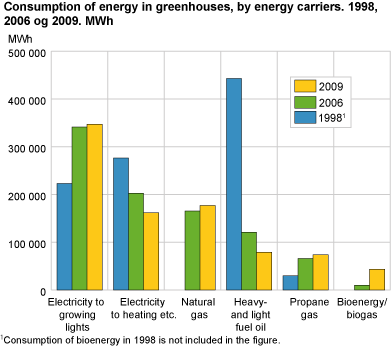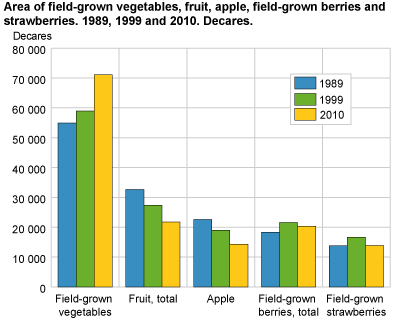Content
Published:
This is an archived release.
More eco-friendly energy in greenhouse industry
The last 10 years have seen a major drop in the use of fuel oil to heat greenhouses, while the use of gas, heating pumps and bioenergy shows a clear increase.
The greenhouse industry uses a great deal of energy for heating and for growing lights, which is one of the industry’s highest costs. In total, the industry spent NOK 359 million on energy in 2009. Each of the 592 enterprises that used heating or growing lights in greenhouses spent an average of NOK 600 000 on this. The total consumption was 884 263 MWh, which corresponds to an average consumption of 1 494 MWh per holding using energy.
There has been a major change in energy goods in the past 10 years. Consumption of fuel oil has fallen by 82 per cent from 1999, while propane gas has increased by 148 per cent. Consumption of bioenergy/biogas has more than quadrupled from 2006 to 2009. No use of natural gas was registered in 1999, but of all the energy goods, this has been the most important in Rogaland in recent years. Natural gas constituted 20 per cent of the total energy in Norway in 2009. .
Fewer holdings - bigger greenhouses1
In 2010, 637 enterprises had a minimum area of 300 m2 of greenhouses. By comparison, there were 957 enterprises with greenhouses in 1999. The total greenhouse area in 2009 was 2 048 decares, which is an increase of 2 per cent from 1999. The greenhouse area per company increased from 2 090 m2 in 1999 to 3 210 m2 in 2010. Rogaland is the county that has the most greenhouse producers, and almost a third of the greenhouse area in Norway is found here.
The growth in the greenhouse area is reflected in the investments. A total of NOK 224.7 million was invested in greenhouses and fittings in 2009. Investments in agricultural buildings with cold storage, packing facilities etc. relate to the whole horticultural sector, and a total of NOK 122.4 million was invested in works buildings related to horticulture.
Fewer horticultural producers - but increase in field-grown horticulture area
The total figure for the horticulture, which covers field-grown horticulture and greenhouses, shows major changes. In line with the general structural changes in agriculture, there are now far fewer horticultural producers. For the horticulture industry as a whole, four out of ten producers have stopped producing in the past 10 years. Almost 60 per cent of the field-grown strawberry producers, 36 per cent of the fruit producers and 45 per cent of the field-grown vegetable producers have stopped producing since 1999.
Although there are fewer producers, there has been a slight increase in the field-grown horticultural area. The area of vegetables increased from 58 900 decares in 1999 to 71 100 decares in 2010. The area of fruit was reduced by 20 per cent, while the area of strawberries has been reduced by 16 per cent since 1999.
More resultsMore detailed results can be given at municipal level where the relevant production is of a certain scope. Please contact Statistics Norway for more detailed statistics.
Horticultural produce is given in the statistics on horticultural produce . |
Tables:
- Table 1 Holdings in various sectors of horticulture, by county. 1979, 1989, 1999 and 2010
- Table 2 Horticultural area, total and area of field-grown vegetables, fruit trees, field-grown berries, greenhouses and nurseries, by county. 1979, 1989, 1999 and 2010. Decares (Corrected 5 January 2012)
- Table 3 Holdings with greenhouses and area of greenhouses, by size of greenhouse area and county. 1979, 1989, 1999 and 2010 (Corrected 13 December 2011 at 1319)
- Table 4 Consumption of energy in greenhouses, by size of greenhouse area and county. 1988, 1998, 2006 and 2009
- Table 5 Holdings with investments and invested amount in greenhouses, incl. leasing, and other buildings used for horticultural production, by county. 1998 and 2009
- Table 6 Labour input in horticulture, total and in various sectors of horticulture, and labour input executed by foreign labour, by county. 19982
- Table 7 Holdings and area of field-grown vegetables, by size of area used for vegetables and county. 1979, 1989, 1999 and 2010 (Corrected 13 December 2011 at 1319)
- Table 8 Holdings which cultivated fruit, by species of fruit trees, county and area of fruit trees. 1979, 1989, 1999 and 2010
- Table 9 Area of fruit trees, by species, county and area. 1979, 1989, 1999 and 2010. Decares
- Table 10 Holdings with field-grown berries, by species and county. 1979, 1989, 1999 and 2010
- Table 11 Area of field-grown berries, by species and county. 1979, 1989, 1999 and 2010. Decares
Contact
-
Cathrine Gran Øverby
E-mail: cathrine.overby@ssb.no
tel.: (+47) 40 85 46 03
-
Berit Bjørlo
E-mail: berit.bjorlo@ssb.no
tel.: (+47) 40 81 13 76


